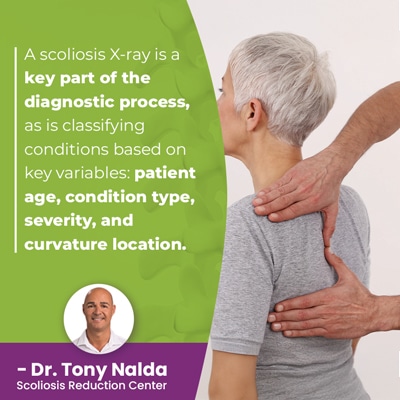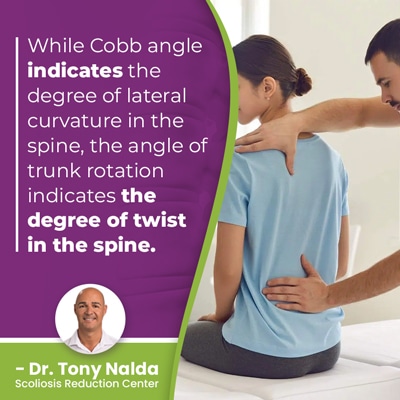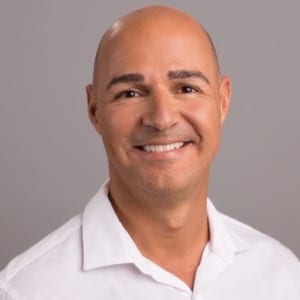What Can a Scoliosis X Ray Reveal About the Condition?

A scoliosis X-ray is needed to fully see what's happening in and around the spine. From confirming the development of an unnatural spinal curvature to the type of curvature, a number of comprehensive images and measurements of the spine are taken.
In order to diagnose scoliosis, a scoliosis X-ray is necessary to confirm the size of the unnatural spinal curve and the rotational component. X-ray results also indicate condition type, severity, and curvature location.
As a patient's scoliosis journey starts with a diagnosis, let's explore the process of diagnosing scoliosis.
Table of Contents
Diagnosing Scoliosis
Current estimates have close to seven million people living with scoliosis in the United States alone.
Diagnosing scoliosis means an unnatural spinal curvature that also twists has developed, and as the leading spinal condition among school-aged children, awareness is necessary.
There was a time when mandatory scoliosis screening was taking place in schools across the United States, but that has since changed, so it's important for parents and/or caregivers to be educated on the condition's early signs because it can lead to early detection and treatment success.
Diagnosing scoliosis means a customized treatment plan can be designed and implemented, and while there are never treatment guarantees, the sooner treatment is started, the better; this is the case with most progressive conditions.
Scoliosis Is Progressive
Being diagnosed with scoliosis means being diagnosed with a progressive condition whose nature is to get worse over time, and this means the size and rotation of the scoliotic curve can become more severe.
As scoliosis progresses, the condition's uneven forces are increasing, as are their effects, and symptoms become more overt, and this can include postural changes in children, movement changes, and pain.
Postural changes disrupt the body's overall symmetry, so this also affects movement; changes to gait, balance, and coordination are common.
Pain is more commonly a part of adult scoliosis because the condition becomes compressive once skeletal maturity has been reached; pain radiating into the extremities due to nerve compression is the most common sign of scoliosis in adults.
We don't always know what triggers the initial onset of scoliosis, but we know it's growth that makes it progress, and we know how to customize a treatment plan accordingly and treat it effectively.
 A scoliosis X-ray is a key part of the diagnostic process, as is classifying conditions based on key variables: patient age, condition type, severity, and curvature location.
A scoliosis X-ray is a key part of the diagnostic process, as is classifying conditions based on key variables: patient age, condition type, severity, and curvature location.
So what exactly does a scoliosis X-ray tell us?
Condition/Curvature Type
Most cases of scoliosis are classified as idiopathic, meaning not clearly associated with a single-known cause, and this accounts for approximately 80 percent of known cases.
Idiopathic scoliosis is the most common type to affect all age groups.
The remaining 20 percent are considered atypical condition types with unique characteristics and treatment needs: neuromuscular scoliosis, congenital scoliosis, and degenerative scoliosis.
On an X-ray, I can see which way the curve bends: to the left or to the right.
Dextroscoliosis vs Levoscoliosis
A right-bending curve (dextroscoliosis) is typical and bends away from the heart; this indicates idiopathic scoliosis. A left-bending curve (levoscoliosis) is atypical as it bends towards the heart, and when I see this on an X-ray, it's a red flag for me that an underlying pathology has caused the scoliosis to develop.
When I see a left-bending curve, I know further testing is going to be necessary to determine the condition type.
Neuromuscular scoliosis tends to be the most severe because the scoliosis develops as a secondary complication of a more-serious neuromuscular condition like spina bifida, muscular dystrophy, or cerebral palsy.
Congenital scoliosis is caused by a malformed spine that develops in utero, and degenerative scoliosis affects older adults and is caused by natural age-related degenerative changes in the spine.
So X-ray imaging can help determine the type of scoliosis by the direction of the curve, and it can also tell me how severe a condition is; this helps me predict the type of treatment plan that should be designed.
Condition Severity
Condition severity is determined during X-ray, and a minimum curve size is needed to be considered a true scoliosis: Cobb angle measurement of at least 10 degrees.
So an X-ray is needed to determine the minimum curve size necessary for a diagnosis is there, but also to determine condition severity.
The measurement involves drawing lines from the tops and bottoms of the curve's most-tilted vertebrae, and the resulting angle is expressed in degrees.
The higher the Cobb angle, the more severe the condition: mild scoliosis (between 10 and 25 degrees), moderate scoliosis (between 25 and 40 degrees), severe scoliosis (40+ degrees), and very-severe scoliosis (80+ degrees).
Cobb angle is known as the gold standard in the diagnosis and assessment of scoliosis and is a key piece of information treatment plans are shaped around.
A scoliosis X-ray can also tell me how much rotation there is in the spine.
Angle of Trunk Rotation
 While Cobb angle indicates the degree of lateral curvature in the spine, the angle of trunk rotation indicates the degree of twist in the spine.
While Cobb angle indicates the degree of lateral curvature in the spine, the angle of trunk rotation indicates the degree of twist in the spine.
Scoliosis makes the spine bend unnaturally to the side, and rotation makes the spine twist from back to front, front to back.
The angle of trunk rotation (ATR) is also important information as it's part of condition severity, and in most cases, the more rotation there is, the more painful a condition is likely to be.
As the spine is one long structure, it's important to determine what part of the spine is most affected.
Curvature Location
The spine has three main sections, and scoliosis can develop in any one section, or in more than one as a combined scoliosis.
The cervical spine refers to the neck; the thoracic spine includes the middle/upper back, and the lumbar spine is the lower back.
So cervical, thoracic, and/or lumbar scoliosis can be diagnosed, and a common combined scoliosis is thoracolumbar scoliosis that develops in the upper lumbar and lower thoracic spine.
Scoliosis can affect the function of the spinal section it develops in, and each section of the spine has its own unique roles to play in spinal biomechanics; the neck has to support the weight of head and allow for the neck to turn easily, and the thoracic spine attaches to the rib cage so helps protect important organs and facilitates a wide range of motion in the trunk. The lumbar spine has to support the weight of the spinal sections above, the entire trunk, and feels the effects of bending, lifting, and twisting motions.
Curvature location tells me where to concentrate my treatment efforts, and it also indicates the types of symptoms a patient can expect; in most cases, the area of the body located the closest to an affected spinal section is most likely to feel its direct effects.
Conclusion
So to summarize, a scoliosis X-ray is needed to officially diagnose the condition by confirming the size of the lateral spinal curvature and the rotational component.
From a scoliosis X-ray, we can determine the condition's type, severity, and location within the spine, and with this information, a customized treatment plan can be crafted.
Here at the Center, a specialized conservative treatment approach is applied so conditions can be impacted on every level, and treatment options include chiropractic care, physical therapy, scoliosis exercises, corrective bracing, and rehabilitation.
Without the information provided by an X-ray, we wouldn't be able to diagnose the condition and customize an effective treatment plan. We wouldn't know precisely where the scoliosis is, in what direction it bends, what type it is, and how severe the condition is.
Scoliosis treatment plans need to be customized to address a patient's specific body type, scoliosis type, and curve type.
Here at the Scoliosis Reduction Center®, the goal is to diagnose scoliosis while early in its progression line because smaller curves are easier to correct than larger curve, and it's easier to work towards preventing continued progression than it is to deal with needing invasive treatment once patients become severe and very severe cases.
It's important for patients to understand that there are no treatment guarantees, but what I can guarantees is that patients of the Center benefit from a multi-faceted treatment approach that gives them access to different types of treatment under one roof; once a patient of the Center, the benefits include a proactive treatment approach with impressive results and the potential to correct their scoliosis.
Dr. Tony Nalda
DOCTOR OF CHIROPRACTIC
After receiving an undergraduate degree in psychology and his Doctorate of Chiropractic from Life University, Dr. Nalda settled in Celebration, Florida and proceeded to build one of Central Florida’s most successful chiropractic clinics.
His experience with patients suffering from scoliosis, and the confusion and frustration they faced, led him to seek a specialty in scoliosis care. In 2006 he completed his Intensive Care Certification from CLEAR Institute, a leading scoliosis educational and certification center.
About Dr. Tony Nalda
 Ready to explore scoliosis treatment? Contact Us Now
Ready to explore scoliosis treatment? Contact Us Now





